本文由Hiroshi Nakamura & NAP授权mooool发表,欢迎转发,禁止以mooool编辑版本转载。
Thanks Hiroshi Nakamura & NAP for authorizing the publication of the project on mooool, Text description provided by Hiroshi Nakamura & NAP.
Hiroshi Nakamura & NAP:这座婚礼教堂坐落在广岛尾道的度假酒店“Bella Vista Sakaigahama”的花园中。教堂位于半山,在这可以欣赏到日本内海的全景。我们通过缠绕两个螺旋楼梯,创建了一个前所未有的建筑,并以一种纯粹的形式体现了婚姻。单个螺旋楼梯在水平方向上来说不够稳定,在垂直方向上容易产生振动,因此极不稳定。
Hiroshi Nakamura & NAP:This wedding chapel stands in a garden of a resort hotel, “Bella Vista Sakaigahama,” in Onomichi, Hiroshima. The site is midway on a hill enjoying a panoramic view of the Inland Sea of Japan. By entwining two spiral stairways, we realized a free-standing building of unprecedented composition and architecturally embodied the act of marriage in a pure form. A single spiral stairway would be unsteady in a horizontal direction and is prone to vibration in a vertical direction, hence, very unstable.
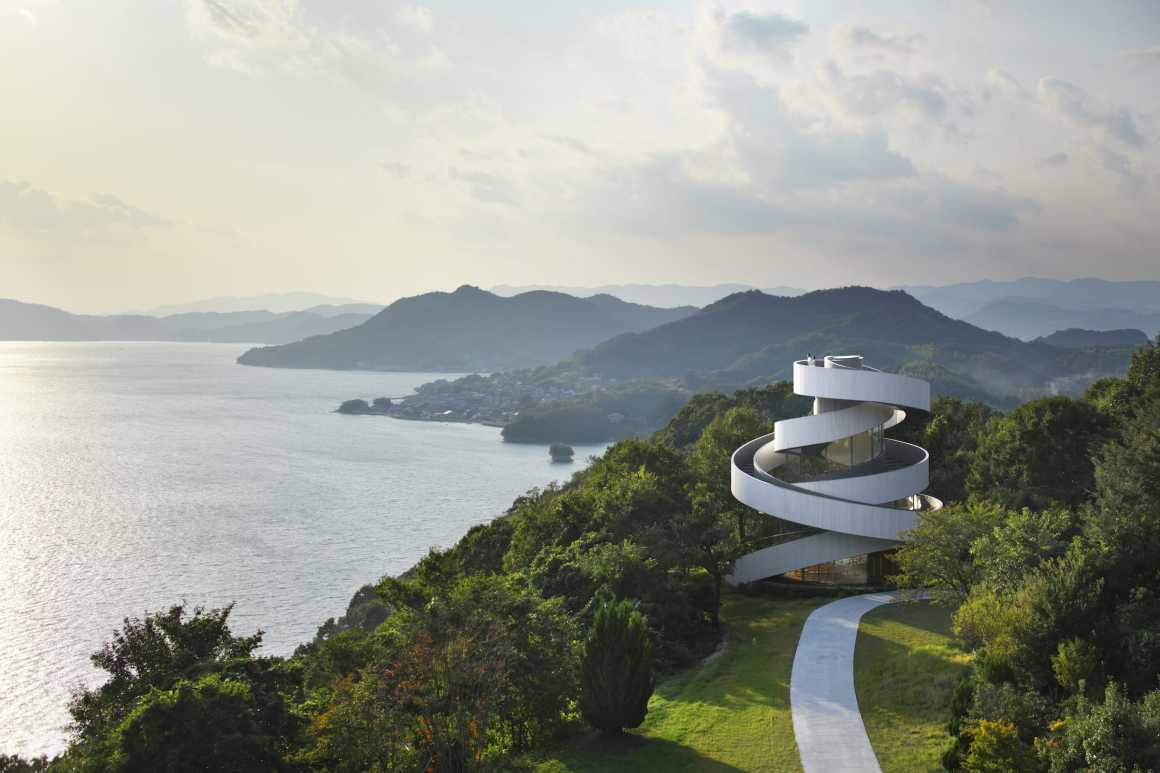
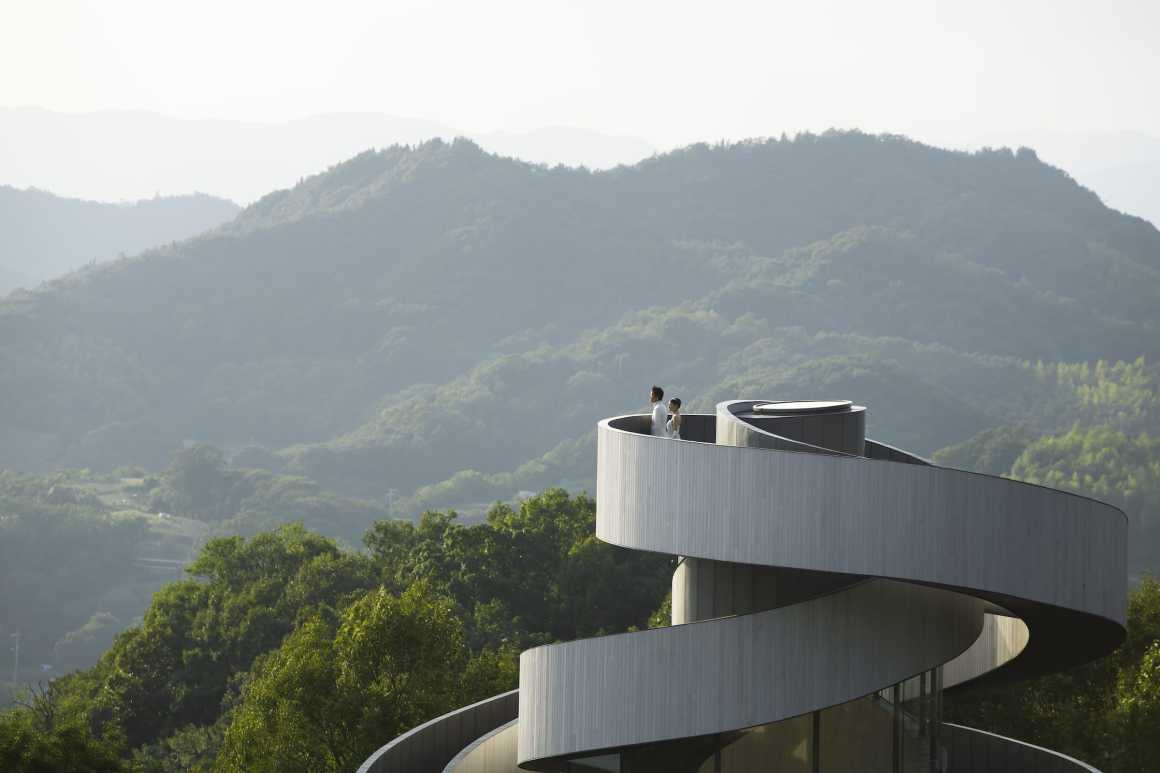
通过连接两个螺旋楼梯,使它们互相支撑,形成了一个独立的结构。就像两个人生在经历了曲折之后相遇、形成一体。这两个螺旋楼梯在15.4米的顶端相接,形成了一条丝带,他们缠绕的核心是一个教堂,新郎和新娘的家人朋友可以在此等候。教堂的走道面向场地原有的树木,圣坛位于树前,而坐在圣坛后的80个座位上都可以透过树看到大海。
By joining two spiral stairways so that one supports the other, we produced a free-standing structure. Just as two lives go through twists and turns before uniting as one, the two spirals seamlessly connect at their 15.4m summit to form a single ribbon. At the core of their movement is a chapel where the people who have supported the bride and groom are waiting. The chapel aisle looks toward an existing symbol tree. The altar stands before the tree, and 80 seats are positioned for views to the ocean through the trees.
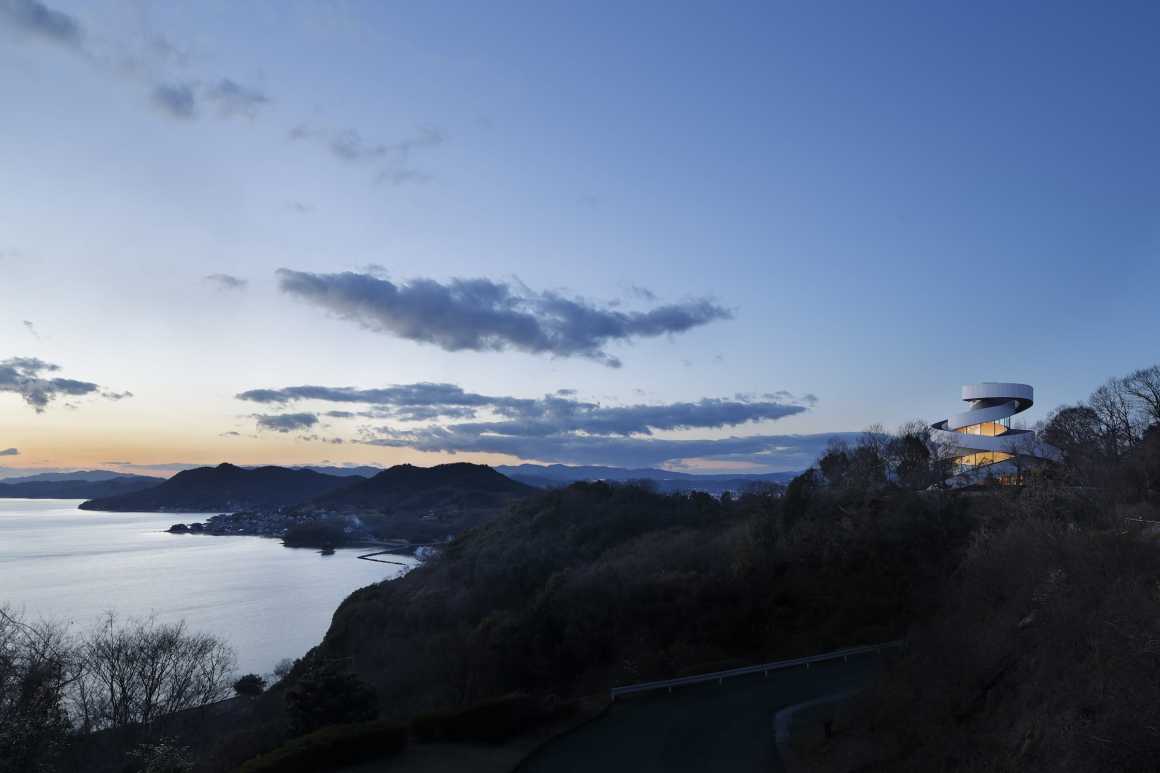
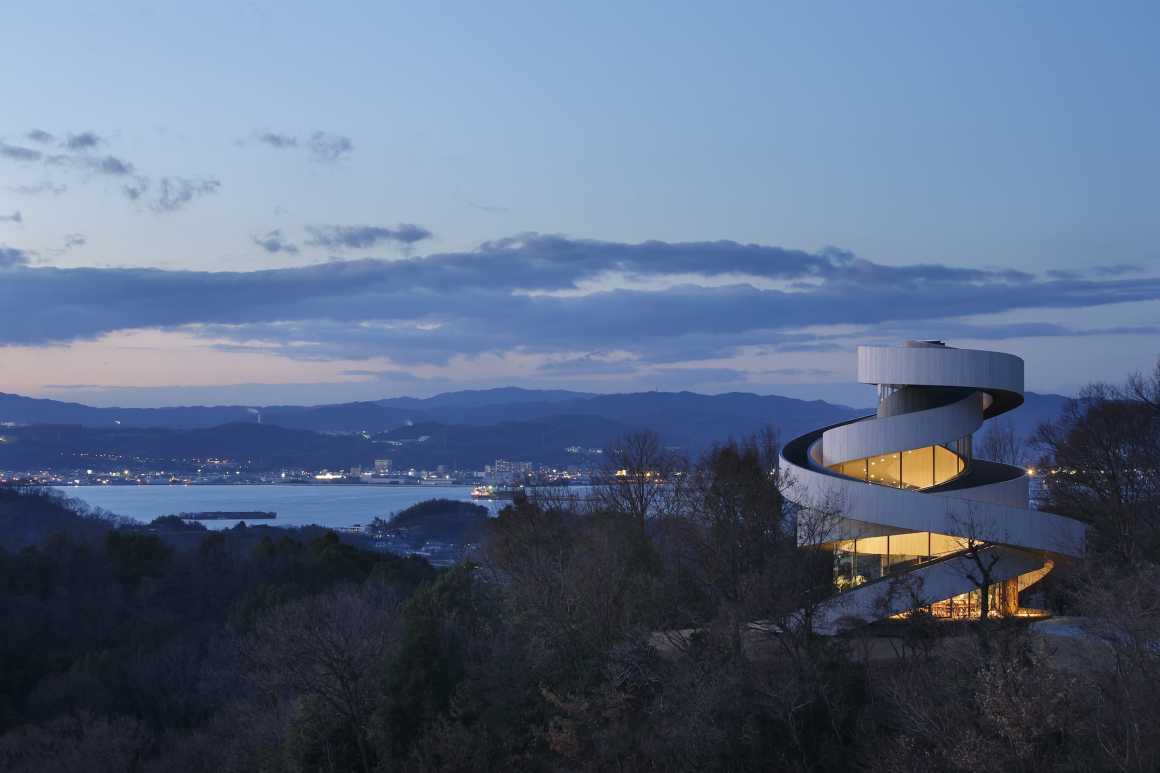
建筑通常由以下元素组成:屋顶、墙壁和地板。然而,这个教堂相互缠绕的楼梯可同时作为屋顶、屋檐、墙壁和地板来创造建筑的空间。楼梯的宽度会随着位置和功能而变化,比如在他们相遇的楼顶,就有良好开阔的视野,以及有些地方的屋檐设计较深,以替建筑内部遮挡阳光。
Ordinarily, a building is composed of distinct elements: roof, wall, and floor. Here, however, the entwining stairways perform as roofs, eaves, walls, and floors to produce the building’s spaces. The stairways widen in breadth in response to location and function, such as at the summit where the couple meets, in directions having fine views, and in places where the eaves must be deep to shield the interior from the sun.

建筑的外立面是漆成白色的直立木板,它会随着时间的推移而愈加美丽,还有钛锌合金这种材料,它能抵抗海风的侵袭,其柔韧度也足够用于弯曲。顶部、墙壁、天花板和窗扇则统一采用锌合金,通过单一材料实现了简单统一的设计。
The building’s exterior is finished in upright wood panels, painted white so as to deepen in beauty as time passes, and titanium zinc alloy, a material resistant to damage from the sea breeze and pliable enough to be applied to curvature. Employing the zinc alloy on the coping, walls, ceiling, and window sashes enabled a simple design unified by means of a single material.
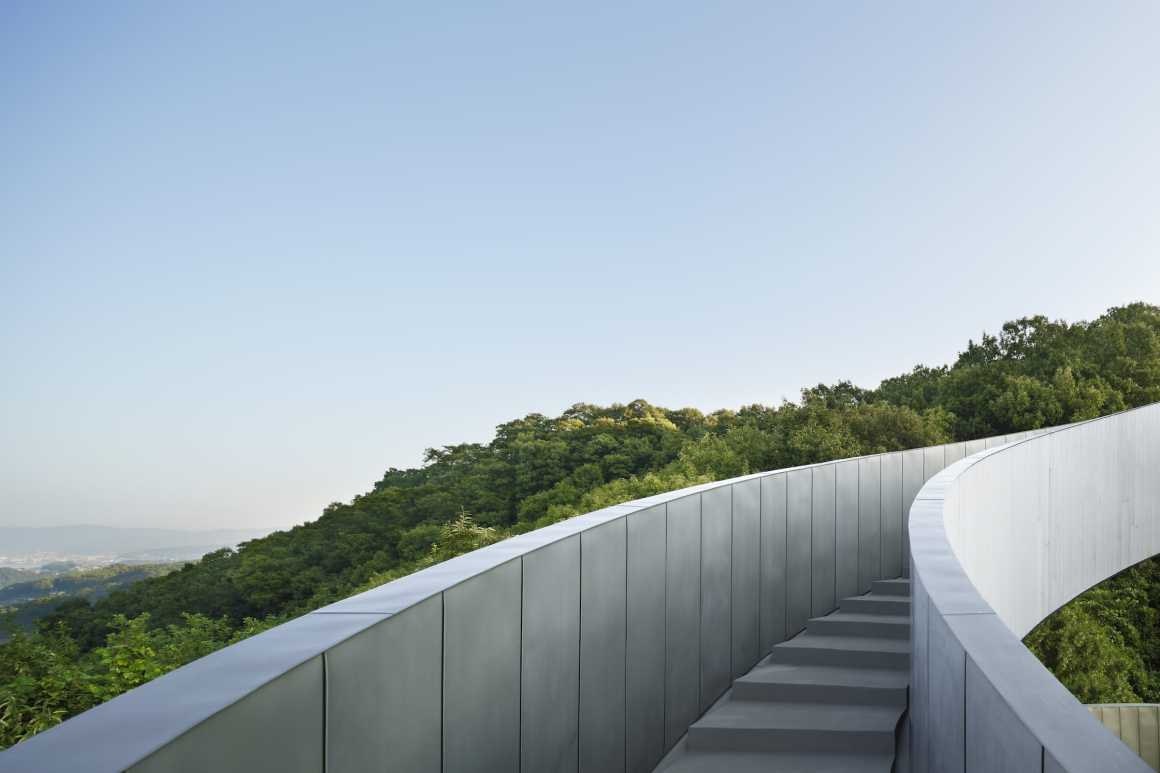

婚礼教堂向来遵循着婚礼的路线而配置,新娘会和她的父亲一起走过一条道路,婚礼结束后,同样一条道路会变成了新郎和新娘的出发路线,在这行走过程中,每一步都会唤醒过去记忆和情感。这个小教堂的婚礼也是根据这样的路线举行的:新郎和新娘走上各自的楼梯,在顶端相遇,祈求上天允许他们结为夫妻并宣布他们的婚姻,然后,从前各自独立生活的两个人一起携手走下楼梯。这个建筑只由这两条小路组成,沿着小路行走,海洋、山脉、天空和遥远岛屿的景色相继出现和消失在视野中。虽然这只是一座小建筑,但我们努力迎合新郎新娘的情感和司仪们的想法,将婚礼的走道延长至160米,扩大了婚礼的体验范围。(Hiroshi Nakamura)
The building type of wedding chapels has always followed a route configuration. The bride walks down the aisle with her father, and after the ceremony, the same aisle becomes a route of departure for the bride and groom. In the process of walking this path, every step awakens memories and emotions. Fortunately, in this chapel, the ceremony also takes form as the bride and groom climb separate stairways to meet at the top, ask for heaven’s permission to join as one, and declare their marriage. The two, who have lived separate lives, then walk back down the stairway together. The simple building is composed only of paths, along which sceneries of ocean, mountains, sky, and distant islands successively appear and disappear. Although it is only a small building, we endeavored to accommodate the emotions of the bride and groom and the thoughts of the celebrants by extending the aisle to a total length of 160m and expanding the range of experiences. (Hiroshi Nakamura)
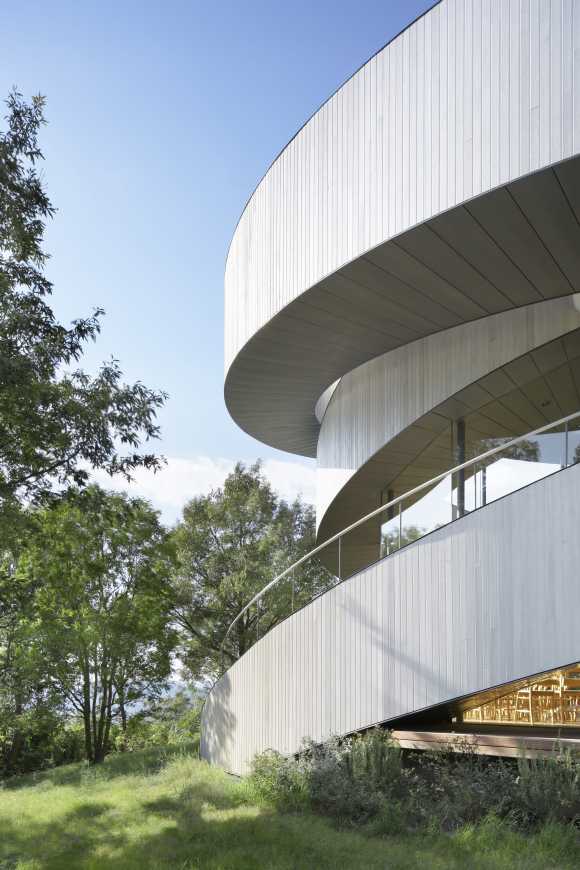
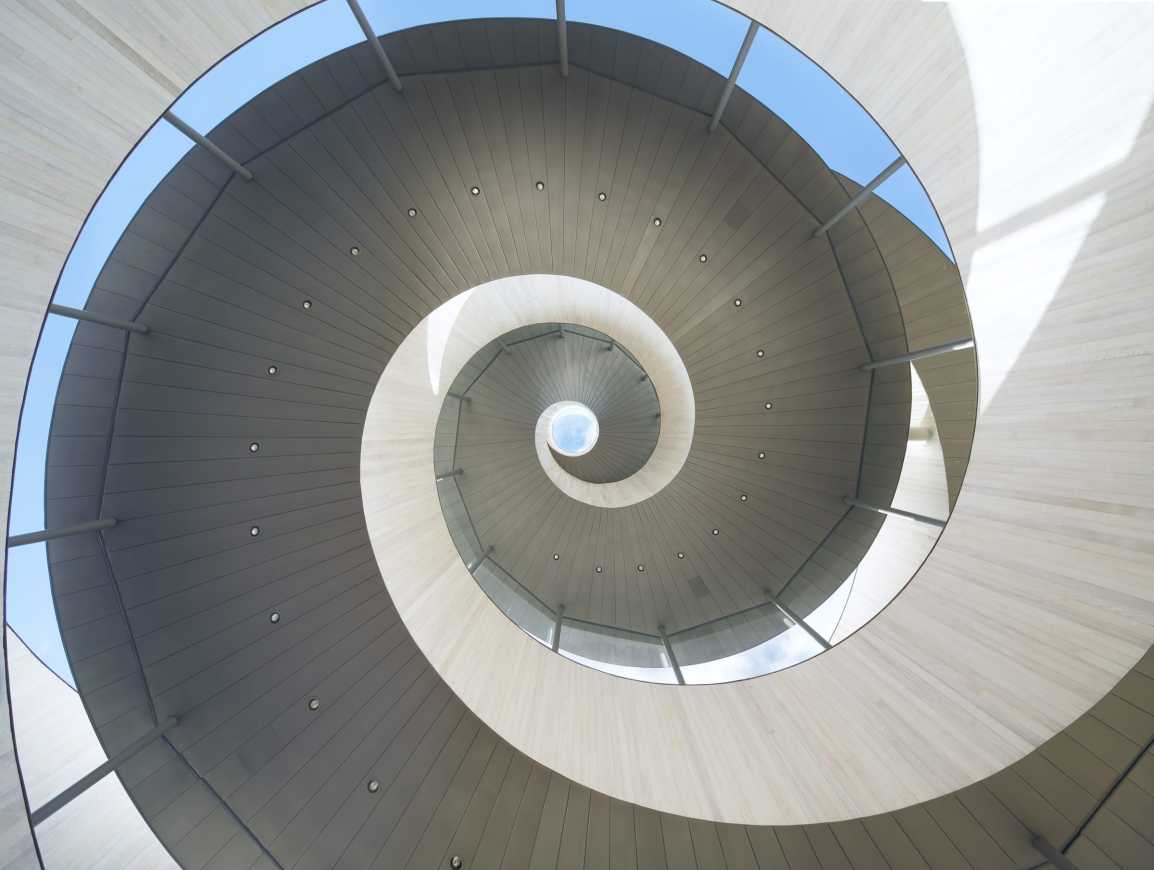

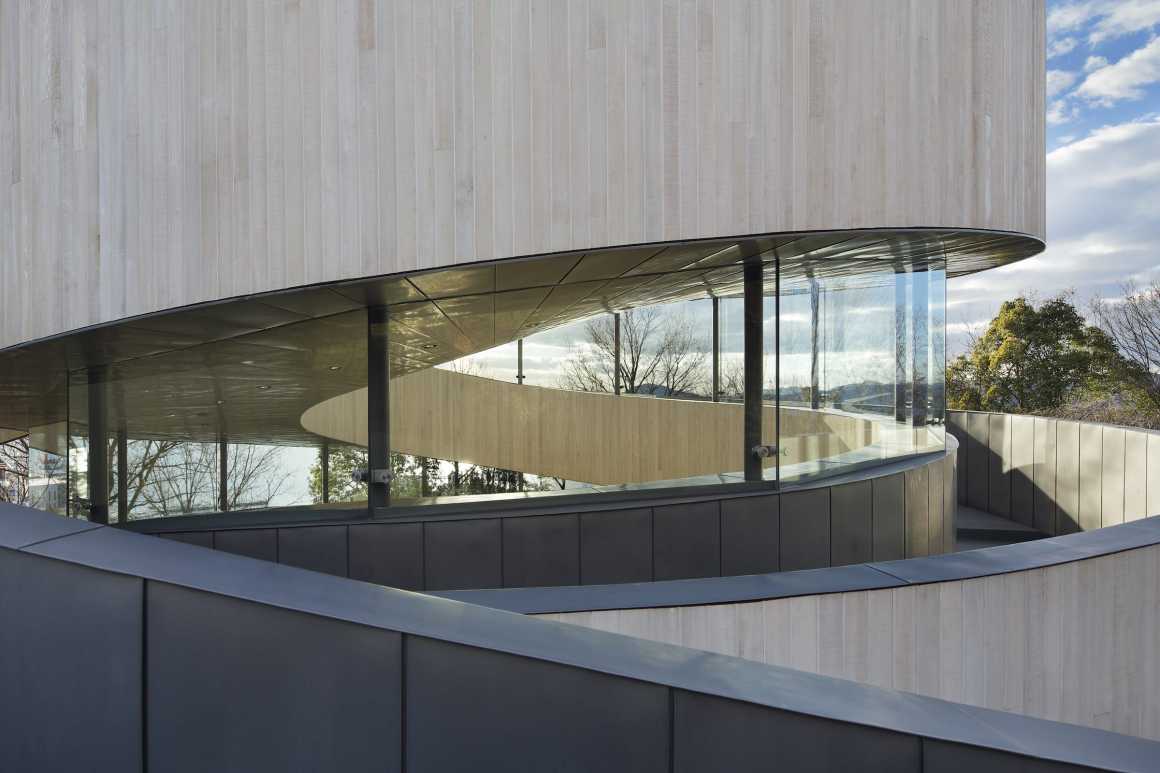
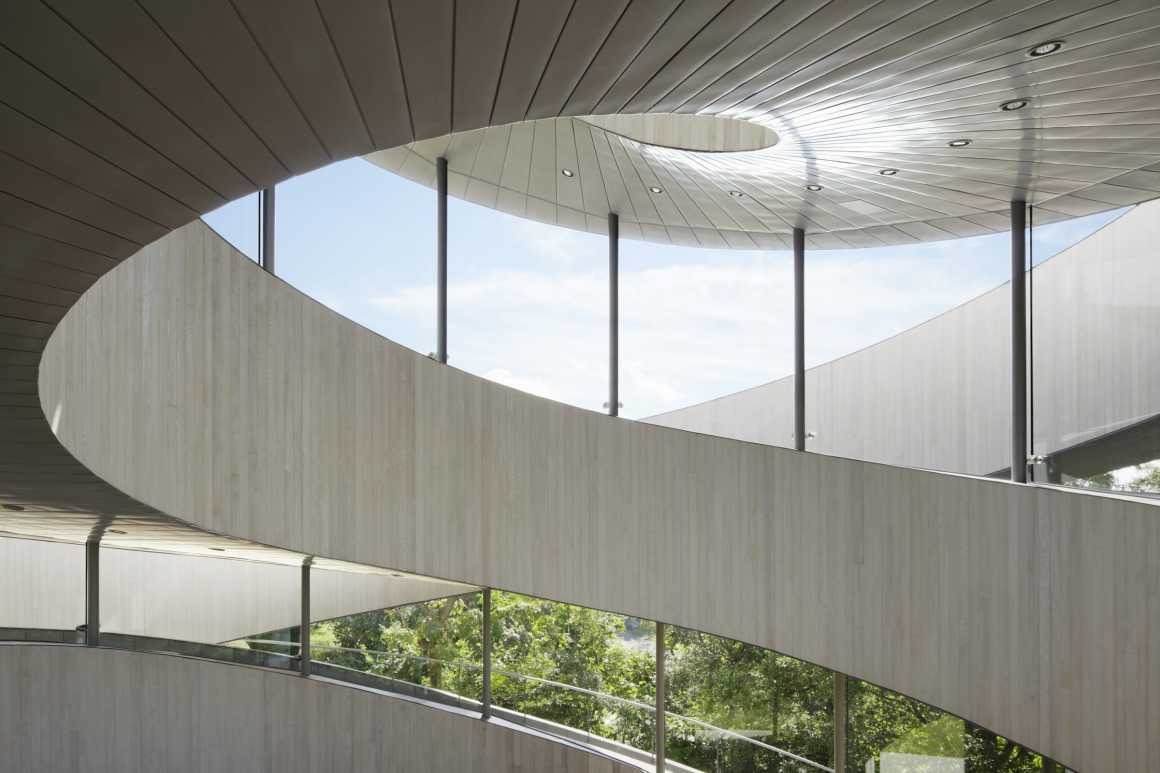
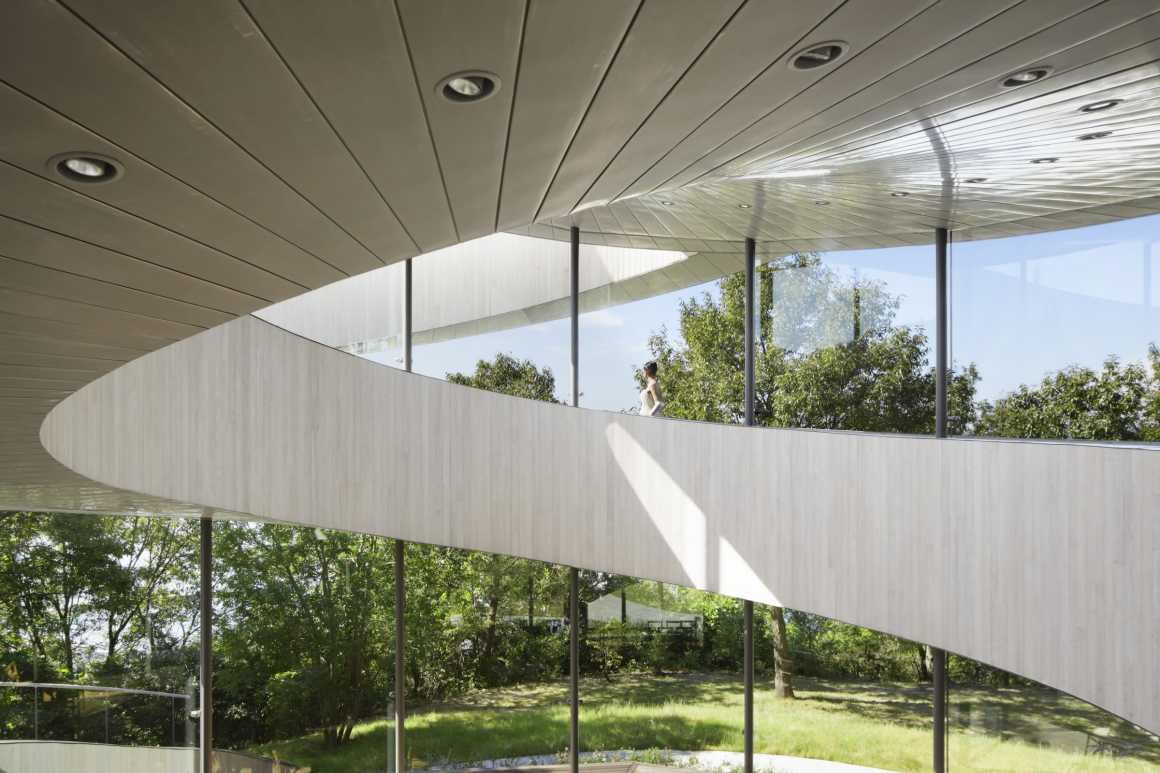


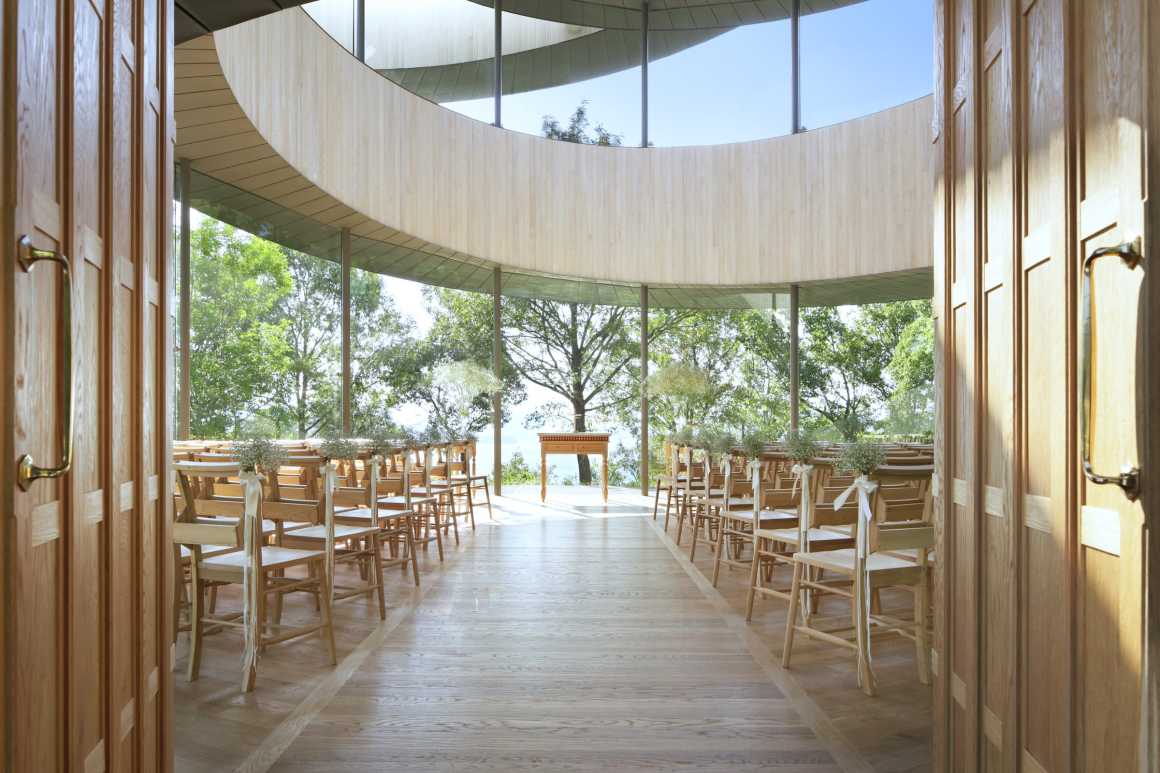
我们通过连接四个方向上的四个点,将这两个楼梯与耦合元件紧密的结合在一起,并通过使两个螺旋相互支撑和独立,产生了抑制向外膨胀的三维环形效应和抵抗水平力的三维支撑效应。直径为100毫米的实心钢中间立柱只承受垂直载荷,支撑着内螺旋结构,外螺旋则以悬垂的形式耦合到内螺旋。为了减轻上部钢架的体积,我们使用了摆式基础隔震装置。在外螺旋楼梯的三个位置,我们建立了一个悬臂式调谐质量阻尼器(TMD)来控制振动。
By connecting the four points in four directions where the two stairways approach closely together with coupling elements, we produced a three-dimensional hoop effect for restraining the outward swell and a three-dimensional brace effect for resisting horizontal forces there by making the two spirals mutually supporting and self-standing. The 100mm-diameter intermediate posts of solid steel which only support the vertical load, sorely support the inner spiral. The outer spiral is coupled to the inner spiral in the form of an overhang. In order to lighten the volume of steel frame in the upper portion, we used a pendulum-type base isolation device for lightweight buildings. At three locations in the outer spiral staircase where we felt the greatest concern about footfall-induced vibration, we established an overhang-type tuned mass damper (TMD) to control the vibration.
▼丝带教堂结构模型 Structural model
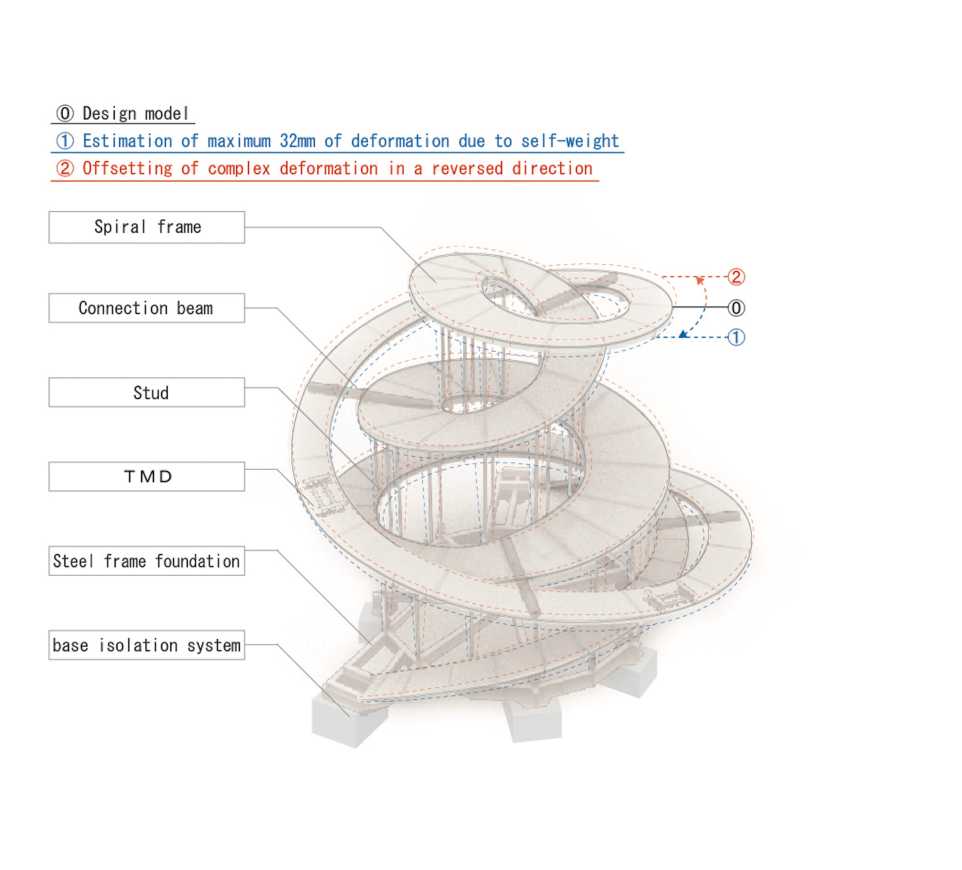
▼丝带教堂剖面图 Section
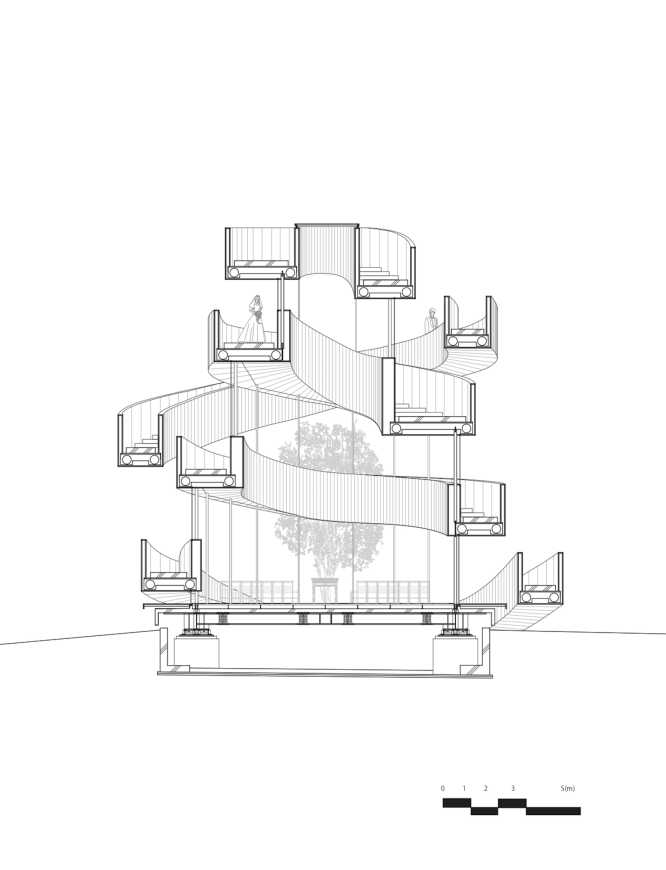
可以预见,当脚手架被拆除时,建筑将在其自身重量下将经历最大30毫米的旋转沉降,这有可能导致中间立柱倾斜,因此,我们开发了一个应用了与导致沉降的预定自然旋转力相同的反向扭矩的结构模型。最后,在建造时故意将这些柱子向建筑倾斜,在建造完成后变得垂直,并将楼层之间的误差保持在2/ 1000的范围内。这种精致而大胆的结构设计是由Arup的Ikuhide Shibata设计的。(Hiroshi Nakamura)
It was foreseen that, when the falsework was removed, the building would undergo maximum 30mm rotational sedimentation under its own weight, which might cause the intermediate posts to lean. We therefore developed a structural model which applies a same amount of reverse torque as the predetermined natural rotational force which causes the sedimentation. As a result, the posts, deliberately leaned for construction, became vertical after the completion of construction and stayed within a 2/1,000 margin of error between floors. This delicate yet bold structural design was created by Ikuhide Shibata of Arup. (Hiroshi Nakamura)
▼丝带教堂剖面示意 Section & text

这些玻璃窗的高度、厚度和形状各不相同。在地震或强风发生时,为了使玻璃板在地震或强风中能够在建筑物的三维扭矩下自由移动,玻璃窗格采用了点状玻璃臂(DPG)固定在钛锌合金顶部突起的内侧。
The glass windows all differ in height, thickness and shape. To enable the glass pane to move freely under the three-dimensional torque of the building during an earthquake or strong winds, the pane is held with dot point glazing (DPG) arms attached to the inner side of the rise of the titanium zinc alloy coping.
▼丝带教堂细节 Detail
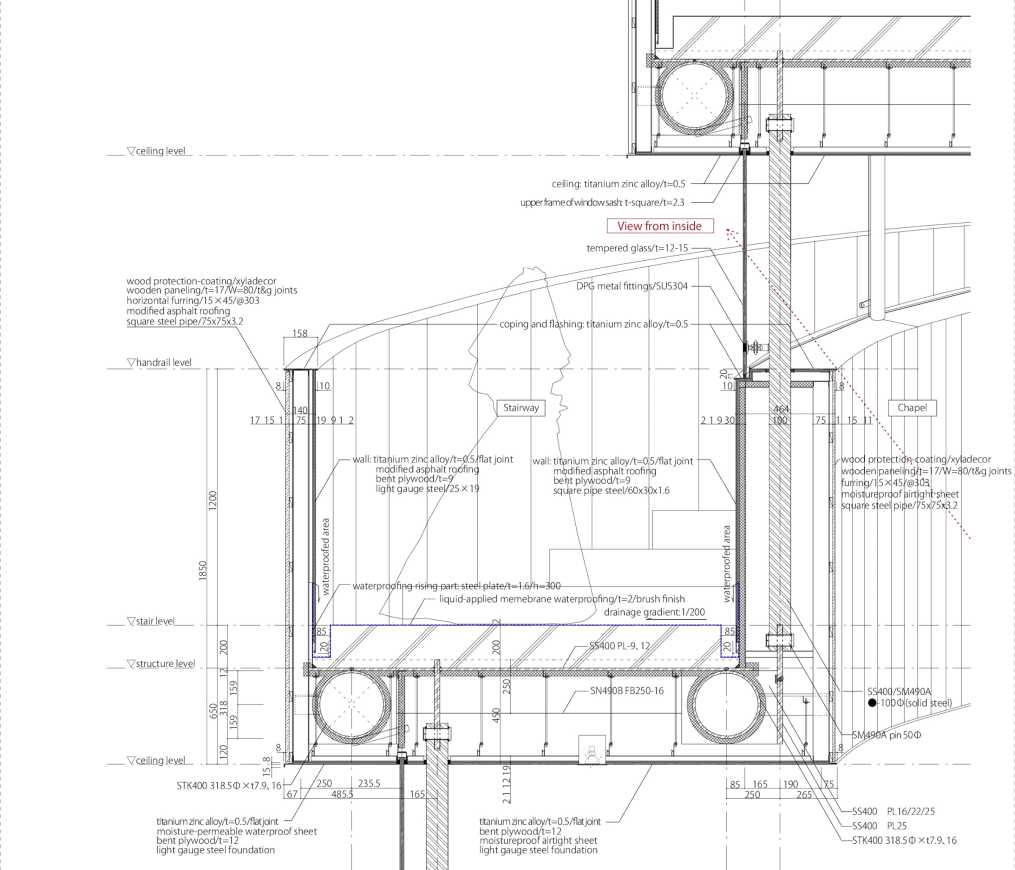
▼基地平面图 Site plan
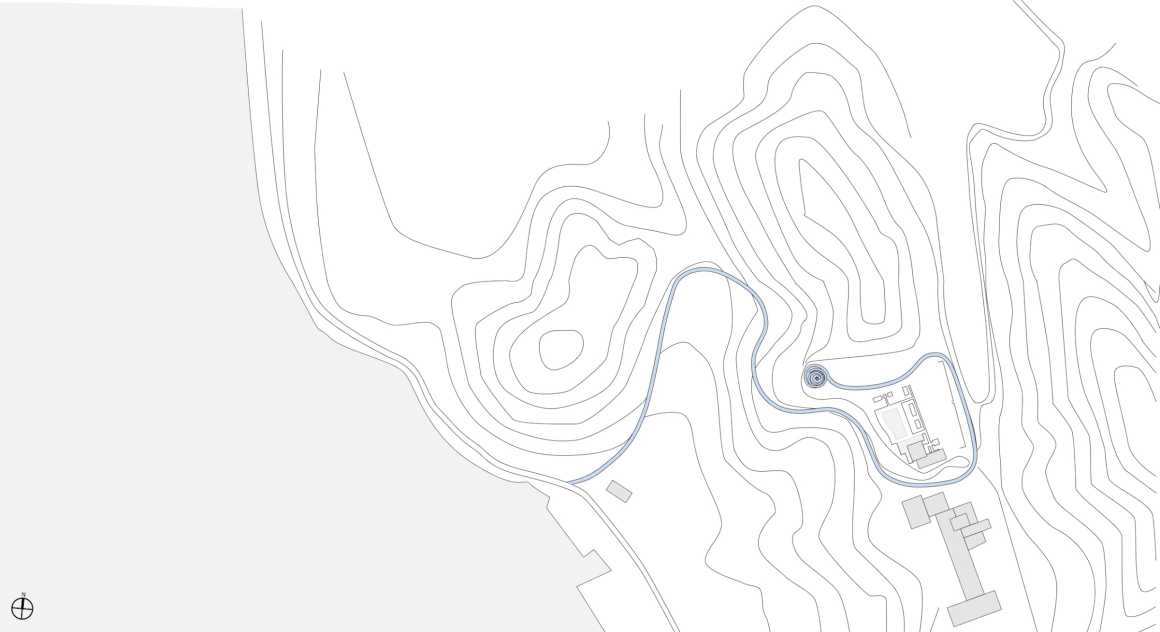
▼丝带教堂一层平面 Ribbon chapel 1F

▼丝带教堂屋顶平面 Ribbon chapel roof plan
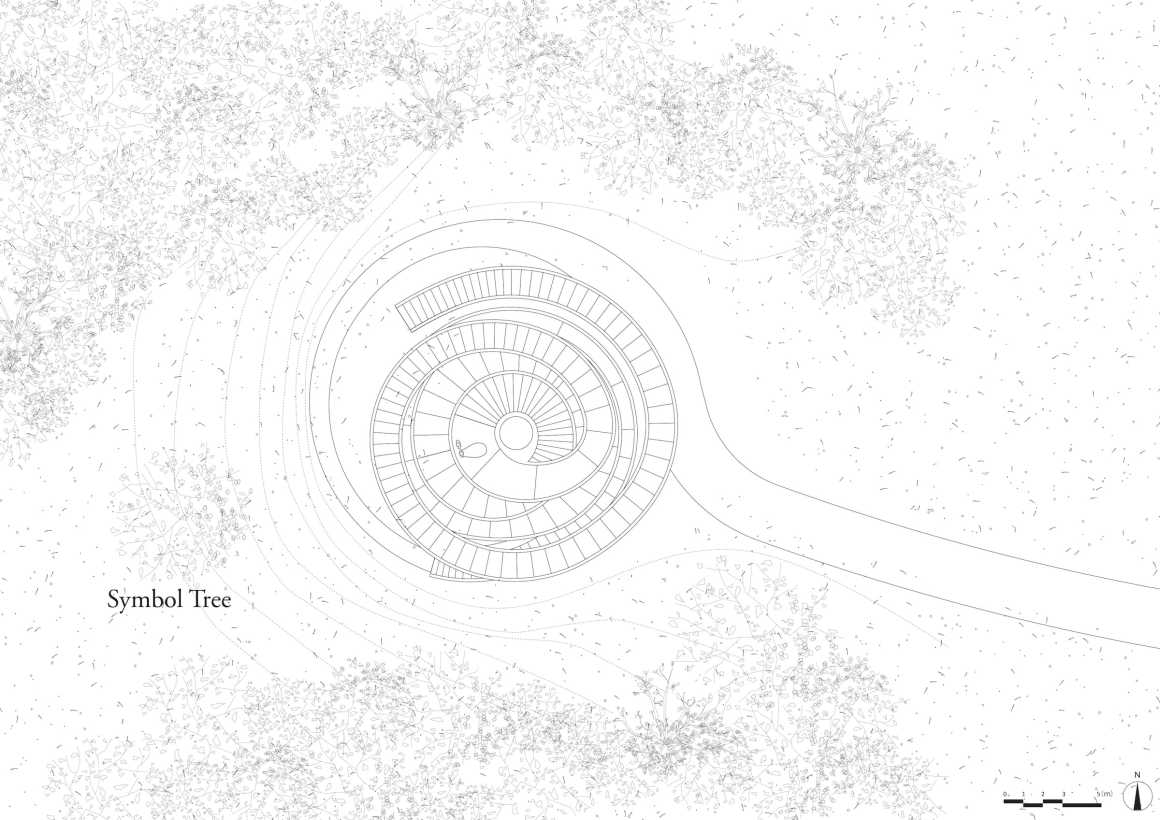
项目名称: 丝带教堂
地点: 日本广岛福山市
设计日期: 2009.02 – 2010.11
完成时间: 2014.01
客户: Tsuneishi Holdings Corporation
建筑设计机构: Hiroshi Nakamura & NAP
合作建筑师: Ikuhide SHIBATA/ Arup
承包商: Kiyoshi HIGAKI/ P.S. Mitsubishi Construction Co., Ltd。
照片: Hiroshi Nakamura & NAP, Koji FUJII/ Nacasa & Partners Inc.
面积:
场地面积: 3000平方米
建筑面积: 72.2平方米
层数: 比地面高一层
结构: 钢结构
Project: Ribbon Chapel
Location: Fukuyama-city, Hiroshima, Japan
Creating Date : 2/2009-11/2010
Completed year: 2014.01
Client: Tsuneishi Holdings Corporation
Architect, Design Agency: Hiroshi Nakamura & NAP
Associate Architect: Ikuhide SHIBATA/ Arup
Contractor: Kiyoshi HIGAKI/ P.S. Mitsubishi Construction Co., Ltd.
Photography : Hiroshi Nakamura & NAP, Koji FUJII/ Nacasa & Partners Inc.
Area:
Site area: 3000m2
Building area: 72.2m2
Floor number: 1 story above the ground
Construction: Steel Construction
更多 Read more about: Hiroshi Nakamura & NAP,Nacasa & Partners Inc.




0 Comments